Composite Outdoor Ceiling Panels: Exploring Durability and Style Possibilities
Welcome to the world of composite outdoor ceiling panels! If you're considering a stylish yet durable option for your outdoor spaces, you've probably come across WPC ceiling panels. In this blog post, we're diving deep into what makes WPC an excellent choice for outdoor ceilings. We'll explore their unmatched durability, which stands up to various weather conditions, and the wide range of styles and designs they offer, ensuring that your outdoor area lasts long and looks fantastic. Whether you're a homeowner, a designer, or just curious about this innovative material, this post will provide you with all the necessary insights into WPC ceiling panels for outdoor use.
What Is WPC Ceiling Panels?
WPC ceiling panels are durable, moisture-resistant ceiling coverings made from a blend of wood fibers and plastic, offering an aesthetic similar to natural wood with the added benefits of low maintenance and easy installation.
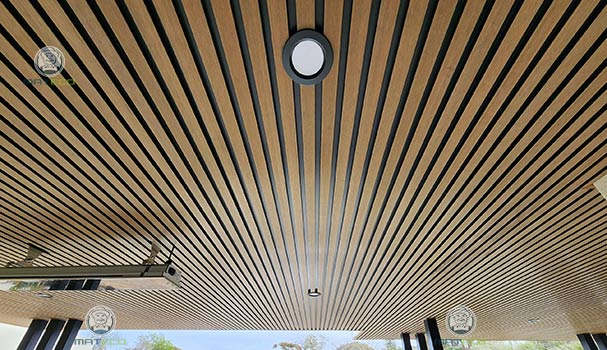
Durability of WPC Ceiling Panels in Outdoor Environments
Durability is a key factor when considering materials for outdoor applications, and this is where composite outdoor ceiling panels truly shine. WPC unique composition gives it a robustness that is ideally suited for withstanding the rigors of outdoor environments. In this section, we'll delve deeper into the aspects that make WPC panels a durable choice for your outdoor ceilings.
1) Weather Resistance
One of the standout features of WPC ceiling panels is their exceptional weather resistance. Unlike traditional wood, which can suffer from warping, rotting, or fading under extreme weather conditions, WPC maintains its integrity and appearance. It can withstand prolonged exposure to sun, rain, and even snow without showing signs of deterioration. The UV resistance of WPC ensures that the panels do not lose their color or gloss over time, making them look new for longer periods. This resilience makes WPC an ideal choice for areas that experience a wide range of weather conditions throughout the year.
2) Temperature and Humidity Fluctuations
Outdoor environments are often subject to temperature and humidity fluctuations, which can be challenging for many materials. WPC ceiling panels, however, handle these changes remarkably well. The combination of wood fibers and plastic in WPC provides a stable material that does not expand or contract significantly with temperature changes. This stability prevents cracking and splitting, common issues in purely wood-based products. Additionally, WPC resistance to moisture helps prevent the growth of mold and mildew, which are common problems in humid environments.
3) Strength and Impact Resistance
In addition to weather resistance, WPC ceiling panels are also known for their strength and impact resistance. They are less likely to dent or get damaged from physical impacts, which is an important consideration for outdoor ceilings that might be exposed to falling branches, hail, or other impacts. This robustness ensures that your ceiling remains not only functional but also aesthetically pleasing over time.
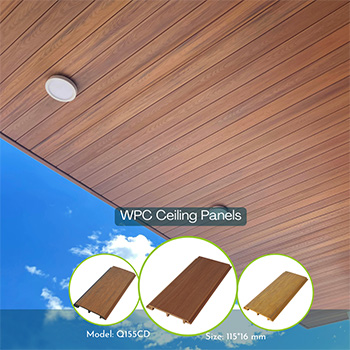
Installation Tips for Outdoor WPC Ceiling Panels
When it comes to installing outdoor WPC ceiling panels, precision and planning are key. The method you choose can impact not only the final appearance but also the longevity of your ceiling. Here’s a step-by-step guide to ensure that your WPC ceiling click panels are installed correctly:
Step 1: Preparing the Ceiling Framework
Firstly, you need to set up the framework on which the WPC panels will be mounted. There are two methods to do this:
Using Hanger Wires:
Begin by fixing hanger wires to the ceiling at the required locations. Ensure that these wires are securely fastened and leveled. Once the hanger wires are in place, attach the framing elements to these wires. It’s critical that the framework is stable and level, as it will support the entire ceiling structure.
Direct Mounting with Screws:
Alternatively, you can fix the framing directly onto the ceiling using screws. This method is straightforward and involves screwing the frame into place, ensuring that it's firmly attached and level.
Remark: No matter which method you opt for, maintain a separation of 30cm between each framing section to provide adequate support and alignment for the panels.
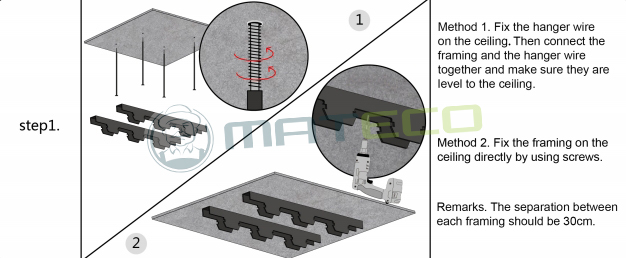
Step2 : Mounting the Ceiling Panels
With the frame ready, you can now begin mounting the WPC ceiling panels. Position the panels into the framework, ensuring that each one clicks into place correctly. This 'click' system is designed for easy installation and a seamless look, but it also requires precision. Make sure each panel is aligned correctly with the corresponding mounting position on the frame.
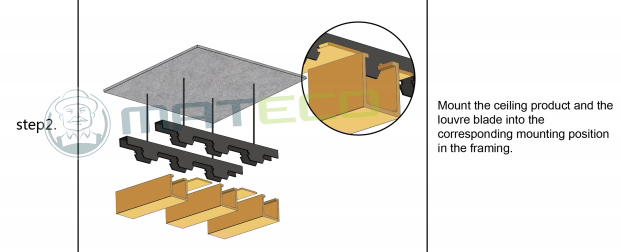
Step 3: Finishing Touches with Trims
After all panels are securely in place, it’s time to add the finishing touches. Install the trim around the edges of the ceiling. Trims not only enhance the visual appeal but also protect the edges of the panels and help conceal any minor discrepancies in alignment or measurement.
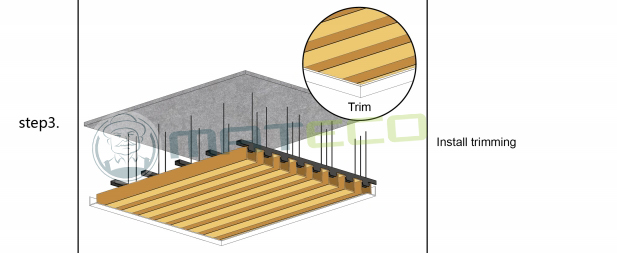
By following these steps, your WPC ceiling will not only look great but will also be built to last, ready to withstand the elements and add style to your outdoor space for years to come.
Comparing WPC with Other Outdoor Ceiling Materials
When outfitting an outdoor space, the choice of ceiling material can significantly impact both the aesthetics and the longevity of the area. WPC (Wood Plastic Composite) has emerged as a popular option, but how does it stack up against traditional outdoor ceiling materials? Let's take a closer look.
1) Traditional Wood Ceilings
Wood has been a classic choice for centuries, valued for its natural beauty and traditional appeal. However, when exposed to the elements, wood can be susceptible to warping, rotting, and insect damage. It requires regular maintenance, including staining, sealing, and sometimes, repair work. In contrast, WPC ceiling panels are impervious to many of these issues. They do not rot or warp, are resistant to insect damage, and need minimal maintenance, making them a more durable and less labor-intensive option.
2) Metal Ceilings
Metal ceilings offer a sleek look and are known for their durability and resistance to fire. An aluminium baffle ceiling is a kind of metal ceiling with a wood slat look. However, they can be prone to rust and corrosion, especially in coastal or humid environments, unless treated with protective coatings, which require maintenance over time. WPC materials, being a combination of wood fibers and plastic, do not rust or corrode, offering a maintenance-free solution while still providing a modern appearance.
3) PVC and Vinyl Ceilings
PVC and vinyl are other synthetic options that are water-resistant and relatively low maintenance. They can be a good choice for a moisture-prone environment but may lack the strength and rigidity of WPC panels. Over time, PVC can become brittle and is more likely to crack under impact or extreme temperature changes. WPC, meanwhile, retains its structural integrity over a wider range of temperatures and is generally more impact-resistant.
4) Fiber Cement Ceilings
Fiber cement is a composite material that is durable and fire-resistant, often used in modern construction. While it is robust, it can be heavy and may require a stronger support structure. Additionally, cutting and installation can be more labor-intensive and may require specialized tools. WPC ceiling panels are usually lighter and easier to install, which can reduce labor costs and time.
5) Plaster and Pop Ceilings
Plaster and POP (Plaster of Paris) are traditional materials that offer a smooth finish and are often used for intricate designs and moldings. However, they are not typically suited for outdoor use where exposure to moisture can lead to deterioration. WPC is inherently moisture-resistant, which makes it a superior choice for outdoor applications.
6) LED ceiling display
This is a way to cover the ceiling with LED panels.LED ceiling display can display fantastic and beautiful videos, but its cost and maintenance cost are high, and it is not suitable for general home use. Instead, LED wall pack lights with a high CRI (>85) were used. These lights perfectly highlight the WPC wall panels, enhancing their color, especially at night, and creating a classical ambiance while being cost-effective and low-maintenance.
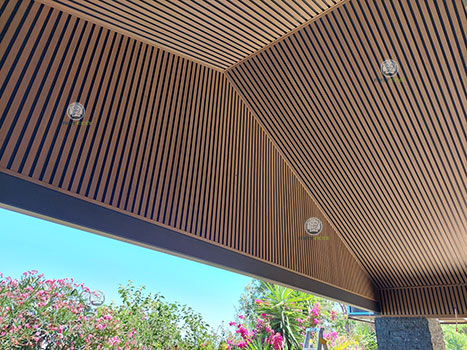
Considerations in Choosing Ceiling Materials
When choosing a material for outdoor ceilings, it is crucial to consider factors such as climate, exposure to the elements, desired maintenance level, and the overall design aesthetic of the space. WPC offers a balanced solution with its durability, low maintenance, and versatility in design. It is particularly well-suited for outdoor environments where longevity and ease of care are priorities. While other materials may offer certain advantages in specific scenarios, WPC tends to be a more all-around practical choice for outdoor ceiling applications.
Maintenance and Care for Outdoor WPC Ceiling Panels
One of the joys of WPC ceiling panels is their low maintenance. Unlike wood, they don’t require regular staining or sealing. Simple cleaning with soap and water is usually enough to keep them looking fresh. If you encounter stubborn stains, a soft-bristle brush can be used. This ease of maintenance means more time enjoying your outdoor space and less time working on it.
Conclusion
In conclusion, composite outdoor ceiling panels are an exceptional choice for outdoor ceilings, offering a perfect blend of durability, style, and environmental responsibility. Whether you’re renovating your patio, decking out a new gazebo, or just looking for a lasting and beautiful outdoor ceiling solution, WPC panels are worth considering. So, are you ready to transform your outdoor space with WPC ceiling panels?
If you are looking for a WPC manufacturer, MATECO WPC will be your best choice.
Website: https://www.matecowpc.com
WhatsApp: +86-13380085620
Email: info@matecowpc.com
















